烟草瞬时转化相关文献
- 格式:pdf
- 大小:425.99 KB
- 文档页数:6
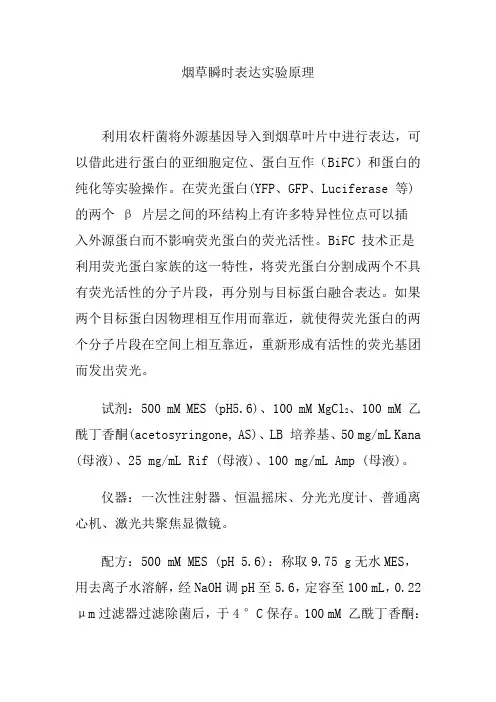
烟草瞬时表达实验原理利用农杆菌将外源基因导入到烟草叶片中进行表达,可以借此进行蛋白的亚细胞定位、蛋白互作(BiFC)和蛋白的纯化等实验操作。
在荧光蛋白(YFP、GFP、Luciferase 等)的两个β 片层之间的环结构上有许多特异性位点可以插入外源蛋白而不影响荧光蛋白的荧光活性。
BiFC 技术正是利用荧光蛋白家族的这一特性,将荧光蛋白分割成两个不具有荧光活性的分子片段,再分别与目标蛋白融合表达。
如果两个目标蛋白因物理相互作用而靠近,就使得荧光蛋白的两个分子片段在空间上相互靠近,重新形成有活性的荧光基团而发出荧光。
试剂:500 mM MES (pH5.6)、100 mM MgCl2、100 mM 乙酰丁香酮(acetosyringone, AS)、LB 培养基、50 mg/mL Kana (母液)、25 mg/mL Rif (母液)、100 mg/mL Amp (母液)。
仪器:一次性注射器、恒温摇床、分光光度计、普通离心机、激光共聚焦显微镜。
配方:500 mM MES (pH 5.6):称取9.75 g无水MES,用去离子水溶解,经NaOH调pH至5.6,定容至100 mL,0.22 μm过滤器过滤除菌后,于4 °C保存。
100 mM 乙酰丁香酮:称取0.196 g乙酰丁香酮,用5 mL DMSO (二甲基亚砜) 溶解,再用去离子水定容至 10 mL,0.22 μm过滤器过滤除菌后,分装1 mL至1.5 mL的EP管中,于-20 °C 保存。
50 mg/mL Kana (母液):称取1 g的Kana粉末,用去离子水溶解并定容至20 mL,0.22 μm过滤器过滤除菌后,分装1 mL至1.5 mL的EP管中,于-20 °C 保存。
100 mg/mL Amp (母液):称取2 g的Amp粉末,用去离子水溶解并定容至20 mL,0.22 μm过滤器过滤除菌后,分装1 mL至1.5 mL的EP管中,于-20 °C 保存。
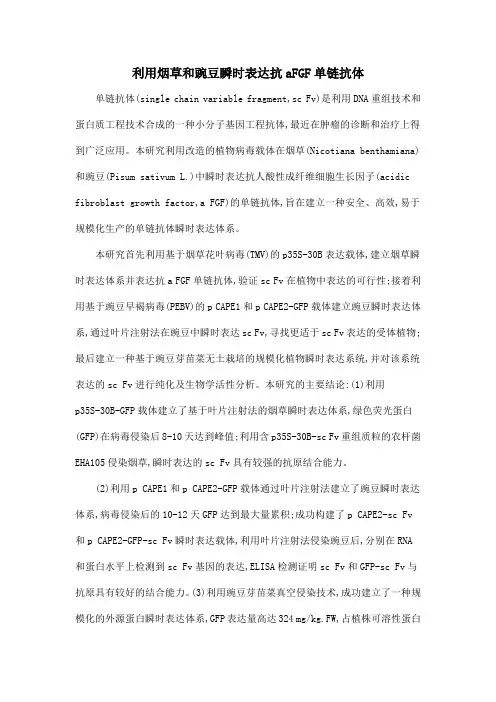
利用烟草和豌豆瞬时表达抗aFGF单链抗体单链抗体(single chain variable fragment,sc Fv)是利用DNA重组技术和蛋白质工程技术合成的一种小分子基因工程抗体,最近在肿瘤的诊断和治疗上得到广泛应用。
本研究利用改造的植物病毒载体在烟草(Nicotiana benthamiana)和豌豆(Pisum sativum L.)中瞬时表达抗人酸性成纤维细胞生长因子(acidic fibroblast growth factor,a FGF)的单链抗体,旨在建立一种安全、高效,易于规模化生产的单链抗体瞬时表达体系。
本研究首先利用基于烟草花叶病毒(TMV)的p35S-30B表达载体,建立烟草瞬时表达体系并表达抗a FGF单链抗体,验证sc Fv在植物中表达的可行性;接着利用基于豌豆早褐病毒(PEBV)的p CAPE1和p CAPE2-GFP载体建立豌豆瞬时表达体系,通过叶片注射法在豌豆中瞬时表达sc Fv,寻找更适于sc Fv表达的受体植物;最后建立一种基于豌豆芽苗菜无土栽培的规模化植物瞬时表达系统,并对该系统表达的sc Fv进行纯化及生物学活性分析。
本研究的主要结论:(1)利用p35S-30B-GFP载体建立了基于叶片注射法的烟草瞬时表达体系,绿色荧光蛋白(GFP)在病毒侵染后8-10天达到峰值;利用含p35S-30B-sc Fv重组质粒的农杆菌EHA105侵染烟草,瞬时表达的sc Fv具有较强的抗原结合能力。
(2)利用p CAPE1和p CAPE2-GFP载体通过叶片注射法建立了豌豆瞬时表达体系,病毒侵染后的10-12天GFP达到最大量累积;成功构建了p CAPE2-sc Fv 和p CAPE2-GFP-sc Fv瞬时表达载体,利用叶片注射法侵染豌豆后,分别在RNA 和蛋白水平上检测到sc Fv基因的表达,ELISA检测证明sc Fv和GFP-sc Fv与抗原具有较好的结合能力。
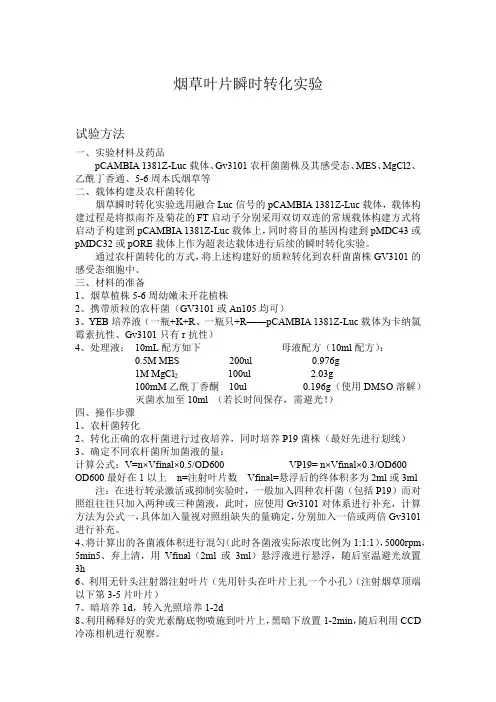
烟草叶片瞬时转化实验试验方法一、实验材料及药品pCAMBIA 1381Z-Luc载体、Gv3101农杆菌菌株及其感受态、MES、MgCl2、乙酰丁香通、5-6周本氏烟草等二、载体构建及农杆菌转化烟草瞬时转化实验选用融合Luc信号的pCAMBIA 1381Z-Luc载体,载体构建过程是将拟南芥及菊花的FT启动子分别采用双切双连的常规载体构建方式将启动子构建到pCAMBIA 1381Z-Luc载体上,同时将目的基因构建到pMDC43或pMDC32或pORE载体上作为超表达载体进行后续的瞬时转化实验。
通过农杆菌转化的方式,将上述构建好的质粒转化到农杆菌菌株GV3101的感受态细胞中。
三、材料的准备1、烟草植株5-6周幼嫩未开花植株2、携带质粒的农杆菌(GV3101或An105均可)3、YEB培养液(一瓶+K+R、一瓶只+R——pCAMBIA 1381Z-Luc载体为卡纳氯霉素抗性、Gv3101只有r抗性)4、处理液:10mL配方如下母液配方(10ml配方):0.5M MES 200ul 0.976g1M MgCl2100ul 2.03g100mM乙酰丁香酮10ul 0.196g(使用DMSO溶解)灭菌水加至10ml (若长时间保存,需避光!)四、操作步骤1、农杆菌转化2、转化正确的农杆菌进行过夜培养,同时培养P19菌株(最好先进行划线)3、确定不同农杆菌所加菌液的量:计算公式:V=n×Vfinal×0.5/OD600 VP19= n×Vfinal×0.3/OD600OD600最好在1以上n=注射叶片数Vfinal=悬浮后的终体积多为2ml或3ml 注:在进行转录激活或抑制实验时,一般加入四种农杆菌(包括P19)而对照组往往只加入两种或三种菌液,此时,应使用Gv3101对体系进行补充,计算方法为公式一,具体加入量视对照组缺失的量确定,分别加入一倍或两倍Gv3101进行补充。
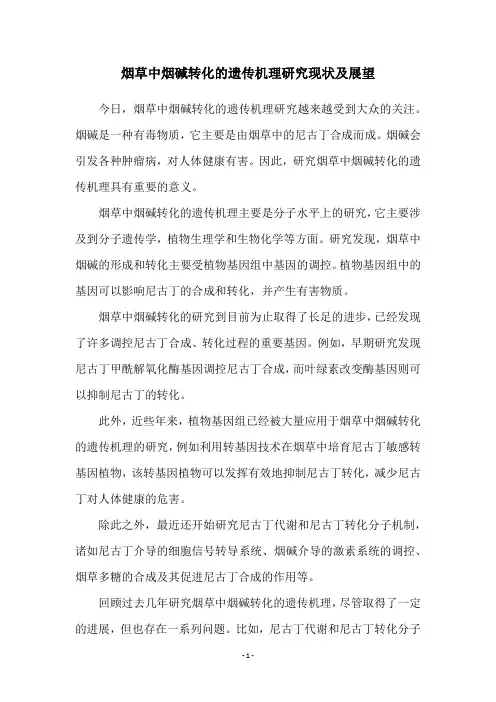
烟草中烟碱转化的遗传机理研究现状及展望今日,烟草中烟碱转化的遗传机理研究越来越受到大众的关注。
烟碱是一种有毒物质,它主要是由烟草中的尼古丁合成而成。
烟碱会引发各种肿瘤病,对人体健康有害。
因此,研究烟草中烟碱转化的遗传机理具有重要的意义。
烟草中烟碱转化的遗传机理主要是分子水平上的研究,它主要涉及到分子遗传学,植物生理学和生物化学等方面。
研究发现,烟草中烟碱的形成和转化主要受植物基因组中基因的调控。
植物基因组中的基因可以影响尼古丁的合成和转化,并产生有害物质。
烟草中烟碱转化的研究到目前为止取得了长足的进步,已经发现了许多调控尼古丁合成、转化过程的重要基因。
例如,早期研究发现尼古丁甲酰解氧化酶基因调控尼古丁合成,而叶绿素改变酶基因则可以抑制尼古丁的转化。
此外,近些年来,植物基因组已经被大量应用于烟草中烟碱转化的遗传机理的研究,例如利用转基因技术在烟草中培育尼古丁敏感转基因植物,该转基因植物可以发挥有效地抑制尼古丁转化,减少尼古丁对人体健康的危害。
除此之外,最近还开始研究尼古丁代谢和尼古丁转化分子机制,诸如尼古丁介导的细胞信号转导系统、烟碱介导的激素系统的调控、烟草多糖的合成及其促进尼古丁合成的作用等。
回顾过去几年研究烟草中烟碱转化的遗传机理,尽管取得了一定的进展,但也存在一系列问题。
比如,尼古丁代谢和尼古丁转化分子机制尚未完全研究清楚,烟草多糖的合成及其促进尼古丁合成的作用等也尚未明确。
另外,在尼古丁合成和转化等方面,转基因技术也仍有待提高,可以研制出高效的转基因植物来有效抑制尼古丁转化,以降低对人体健康的危害。
在未来,烟草中烟碱转化的遗传机理的研究将继续受到关注,将朝着系统化、全面化、分子生物学和分子育种方面发展。
同时,对于尼古丁代谢和尼古丁转化分子机制、烟草多糖的合成及其促进尼古丁合成的作用等仍然有很多未知因素,仍需要进一步研究和探讨。
综上所述,烟草中烟碱转化的遗传机理的研究具有重要的意义,将为研究尼古丁合成和转化的分子机制,以及烟草多糖的合成及其促进尼古丁合成的作用等提供有力的技术手段和理论支持,以抑制尼古丁对人体健康的危害。
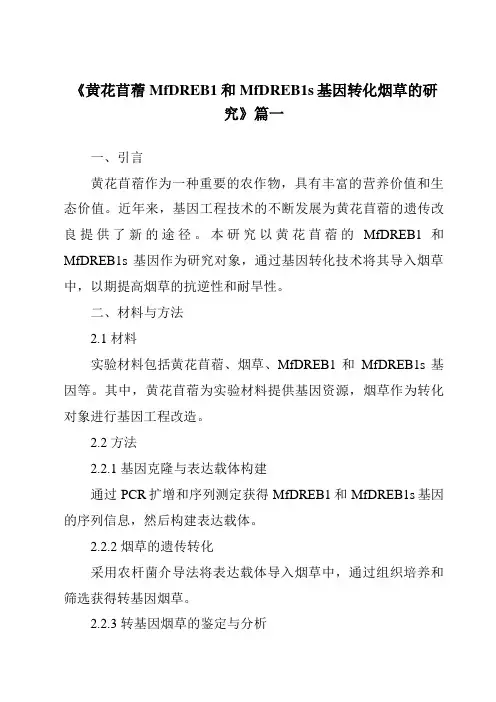
《黄花苜蓿MfDREB1和MfDREB1s基因转化烟草的研究》篇一一、引言黄花苜蓿作为一种重要的农作物,具有丰富的营养价值和生态价值。
近年来,基因工程技术的不断发展为黄花苜蓿的遗传改良提供了新的途径。
本研究以黄花苜蓿的MfDREB1和MfDREB1s基因作为研究对象,通过基因转化技术将其导入烟草中,以期提高烟草的抗逆性和耐旱性。
二、材料与方法2.1 材料实验材料包括黄花苜蓿、烟草、MfDREB1和MfDREB1s基因等。
其中,黄花苜蓿为实验材料提供基因资源,烟草作为转化对象进行基因工程改造。
2.2 方法2.2.1 基因克隆与表达载体构建通过PCR扩增和序列测定获得MfDREB1和MfDREB1s基因的序列信息,然后构建表达载体。
2.2.2 烟草的遗传转化采用农杆菌介导法将表达载体导入烟草中,通过组织培养和筛选获得转基因烟草。
2.2.3 转基因烟草的鉴定与分析对转基因烟草进行PCR鉴定和RT-PCR分析,验证基因是否成功导入并表达。
同时,对转基因烟草进行抗逆性和耐旱性分析。
三、实验结果3.1 基因克隆与表达载体构建通过PCR扩增和序列测定成功获得了MfDREB1和MfDREB1s基因的序列信息,构建了相应的表达载体。
经测序验证,表达载体中的基因序列与黄花苜蓿中的基因序列一致。
3.2 烟草的遗传转化采用农杆菌介导法成功将表达载体导入烟草中,经过组织培养和筛选,获得了转基因烟草。
PCR鉴定结果显示,转基因烟草中成功导入了MfDREB1和MfDREB1s基因。
3.3 转基因烟草的鉴定与分析RT-PCR分析表明,转基因烟草中的MfDREB1和MfDREB1s基因得到了表达。
抗逆性和耐旱性分析显示,转基因烟草的抗逆性和耐旱性得到了显著提高。
与未转化的烟草相比,转基因烟草在干旱条件下的生长状况更好,叶片颜色更绿,生长速度更快。
四、讨论本研究成功将黄花苜蓿的MfDREB1和MfDREB1s基因导入烟草中,并通过转基因技术获得了转基因烟草。
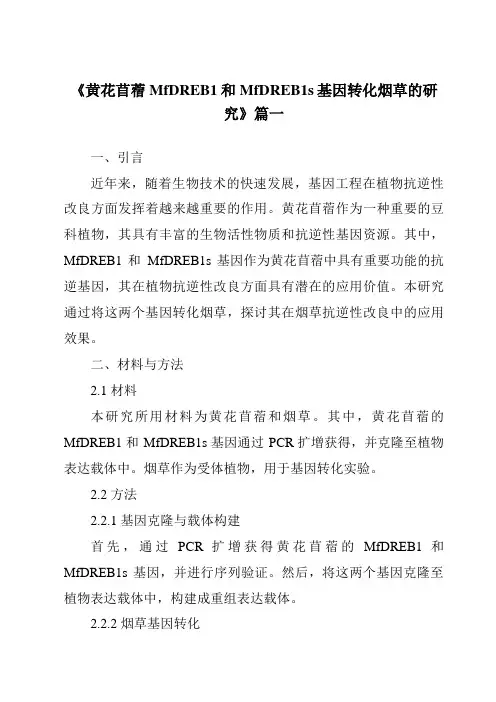
《黄花苜蓿MfDREB1和MfDREB1s基因转化烟草的研究》篇一一、引言近年来,随着生物技术的快速发展,基因工程在植物抗逆性改良方面发挥着越来越重要的作用。
黄花苜蓿作为一种重要的豆科植物,其具有丰富的生物活性物质和抗逆性基因资源。
其中,MfDREB1和MfDREB1s基因作为黄花苜蓿中具有重要功能的抗逆基因,其在植物抗逆性改良方面具有潜在的应用价值。
本研究通过将这两个基因转化烟草,探讨其在烟草抗逆性改良中的应用效果。
二、材料与方法2.1 材料本研究所用材料为黄花苜蓿和烟草。
其中,黄花苜蓿的MfDREB1和MfDREB1s基因通过PCR扩增获得,并克隆至植物表达载体中。
烟草作为受体植物,用于基因转化实验。
2.2 方法2.2.1 基因克隆与载体构建首先,通过PCR扩增获得黄花苜蓿的MfDREB1和MfDREB1s基因,并进行序列验证。
然后,将这两个基因克隆至植物表达载体中,构建成重组表达载体。
2.2.2 烟草基因转化采用农杆菌介导的叶盘法,将构建好的重组表达载体转化至烟草中。
转化后的烟草在含有相应选择压力的培养基上进行筛选和培养。
2.2.3 转基因烟草的鉴定与分析通过PCR和RT-PCR等方法,对转基因烟草进行鉴定和分析。
同时,对转基因烟草进行抗逆性实验,观察其在干旱、盐碱等逆境条件下的生长情况。
三、结果与分析3.1 基因克隆与载体构建结果通过PCR扩增获得黄花苜蓿的MfDREB1和MfDREB1s基因,并成功将其克隆至植物表达载体中。
序列验证结果表明,克隆的基因序列与原序列一致,无突变现象。
3.2 烟草基因转化结果采用农杆菌介导的叶盘法,将构建好的重组表达载体转化至烟草中。
经过筛选和培养,成功获得转基因烟草。
PCR和RT-PCR鉴定结果表明,转基因烟草中成功插入了MfDREB1和MfDREB1s基因。
3.3 转基因烟草的抗逆性分析对转基因烟草进行抗逆性实验,观察其在干旱、盐碱等逆境条件下的生长情况。
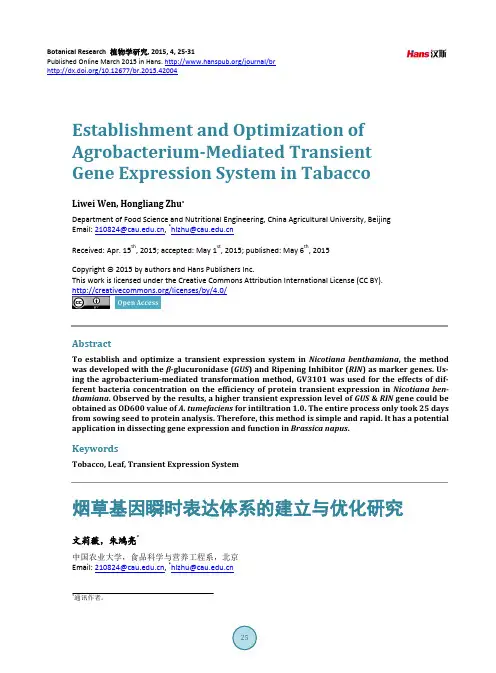
Botanical Research 植物学研究, 2015, 4, 25-31Published Online March 2015 in Hans. /journal/br/10.12677/br.2015.42004Establishment and Optimization ofAgrobacterium-Mediated TransientGene Expression System in TabaccoLiwei Wen, Hongliang Zhu*Department of Food Science and Nutritional Engineering, China Agricultural University, BeijingEmail: 210824@, *hlzhu@Received: Apr. 15th, 2015; accepted: May 1st, 2015; published: May 6th, 2015Copyright © 2015 by authors and Hans Publishers Inc.This work is licensed under the Creative Commons Attribution International License (CC BY)./licenses/by/4.0/AbstractTo establish and optimize a transient expression system in Nicotiana benthamiana, the method was developed with the β-glucuronidase (GUS) and Ripening Inhibitor (RIN) as marker genes. Us-ing the agrobacterium-mediated transformation method, GV3101 was used for the effects of dif-ferent bacteria concentration on the efficiency of protein transient expression in Nicotiana ben-thamiana. Observed by the results, a higher transient expression level of GUS & RIN gene could be obtained as OD600 value of A. tumefaciens for intiltration 1.0. The entire process only took 25 days from sowing seed to protein analysis. Therefore, this method is simple and rapid. It has a potential application in dissecting gene expression and function in Brassica napus.KeywordsTobacco, Leaf, Transient Expression System烟草基因瞬时表达体系的建立与优化研究文莉薇,朱鸿亮*中国农业大学,食品科学与营养工程系,北京Email: 210824@, *hlzhu@*通讯作者。
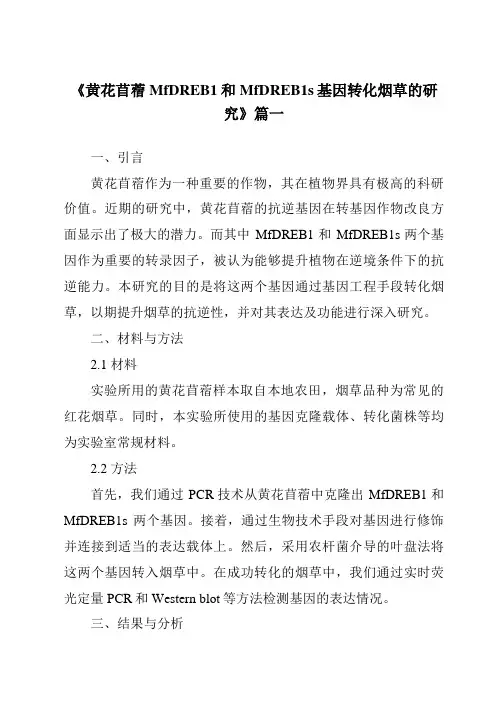
《黄花苜蓿MfDREB1和MfDREB1s基因转化烟草的研究》篇一一、引言黄花苜蓿作为一种重要的作物,其在植物界具有极高的科研价值。
近期的研究中,黄花苜蓿的抗逆基因在转基因作物改良方面显示出了极大的潜力。
而其中MfDREB1和MfDREB1s两个基因作为重要的转录因子,被认为能够提升植物在逆境条件下的抗逆能力。
本研究的目的是将这两个基因通过基因工程手段转化烟草,以期提升烟草的抗逆性,并对其表达及功能进行深入研究。
二、材料与方法2.1 材料实验所用的黄花苜蓿样本取自本地农田,烟草品种为常见的红花烟草。
同时,本实验所使用的基因克隆载体、转化菌株等均为实验室常规材料。
2.2 方法首先,我们通过PCR技术从黄花苜蓿中克隆出MfDREB1和MfDREB1s两个基因。
接着,通过生物技术手段对基因进行修饰并连接到适当的表达载体上。
然后,采用农杆菌介导的叶盘法将这两个基因转入烟草中。
在成功转化的烟草中,我们通过实时荧光定量PCR和Western blot等方法检测基因的表达情况。
三、结果与分析3.1 基因克隆与序列分析通过PCR技术成功克隆出MfDREB1和MfDREB1s两个基因,经过测序验证,基因序列与预期一致,无突变现象。
3.2 基因转化烟草通过农杆菌介导的叶盘法成功将MfDREB1和MfDREB1s两个基因转入烟草中。
经过PCR检测,确认转基因烟草阳性率较高。
3.3 基因表达分析实时荧光定量PCR和Western blot结果显示,转基因烟草中MfDREB1和MfDREB1s基因的表达量明显高于非转基因烟草。
这表明这两个基因在烟草中得到了有效表达。
四、讨论本研究成功将黄花苜蓿的MfDREB1和MfDREB1s两个基因转化入烟草中,并对其表达进行了分析。
结果显示,这两个基因在烟草中的表达能够有效提升烟草的抗逆性。
这为今后通过基因工程手段改良烟草等作物的抗逆性提供了新的思路和方法。
然而,本研究还存在一定的局限性。
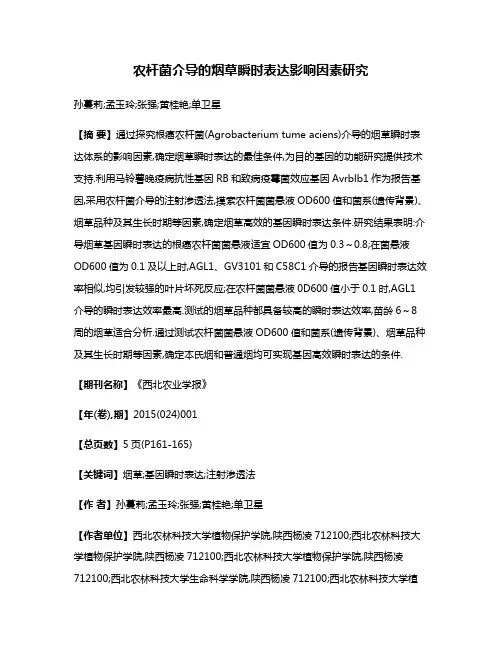
农杆菌介导的烟草瞬时表达影响因素研究孙蔓莉;孟玉玲;张强;黄桂艳;单卫星【摘要】通过探究根癌农杆菌(Agrobacterium tume aciens)介导的烟草瞬时表达体系的影响因素,确定烟草瞬时表达的最佳条件,为目的基因的功能研究提供技术支持.利用马铃薯晚疫病抗性基因RB和致病疫霉菌效应基因Avrblb1作为报告基因,采用农杆菌介导的注射渗透法,摸索农杆菌菌悬液OD600值和菌系(遗传背景)、烟草品种及其生长时期等因素,确定烟草高效的基因瞬时表达条件.研究结果表明:介导烟草基因瞬时表达的根癌农杆菌菌悬液适宜OD600值为0.3~0.8;在菌悬液OD600值为0.1及以上时,AGL1、GV3101和C58C1介导的报告基因瞬时表达效率相似,均引发较强的叶片坏死反应;在农杆菌菌悬液0D600值小于0.1时,AGL1介导的瞬时表达效率最高.测试的烟草品种都具备较高的瞬时表达效率,苗龄6~8周的烟草适合分析.通过测试农杆菌菌悬液OD600值和菌系(遗传背景)、烟草品种及其生长时期等因素,确定本氏烟和普通烟均可实现基因高效瞬时表达的条件.【期刊名称】《西北农业学报》【年(卷),期】2015(024)001【总页数】5页(P161-165)【关键词】烟草;基因瞬时表达;注射渗透法【作者】孙蔓莉;孟玉玲;张强;黄桂艳;单卫星【作者单位】西北农林科技大学植物保护学院,陕西杨凌712100;西北农林科技大学植物保护学院,陕西杨凌712100;西北农林科技大学植物保护学院,陕西杨凌712100;西北农林科技大学生命科学学院,陕西杨凌712100;西北农林科技大学植物保护学院,陕西杨凌712100;旱区作物逆境生物学国家重点实验室,陕西杨凌712100【正文语种】中文【中图分类】S432.2在植物组织中可通过2种方法表达异源基因:稳定表达和瞬时表达[1]。
瞬时表达较前者具有简单、快速、周期短、准确等优点,表达效率稳定,转化率高,并且不产生可遗传的子代,生物安全性高[2]。
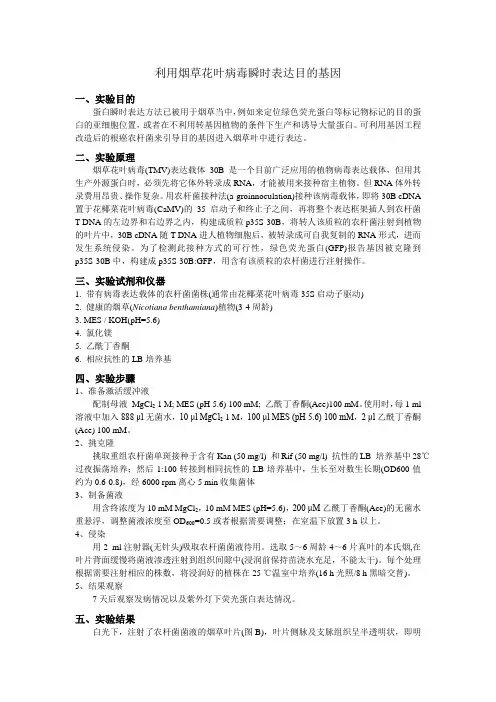
利用烟草花叶病毒瞬时表达目的基因一、实验目的蛋白瞬时表达方法已被用于烟草当中,例如来定位绿色荧光蛋白等标记物标记的目的蛋白的亚细胞位置,或者在不利用转基因植物的条件下生产和诱导大量蛋白。
可利用基因工程改造后的根癌农杆菌来引导目的基因进入烟草叶中进行表达。
二、实验原理烟草花叶病毒(TMV)表达载体30B是一个目前广泛应用的植物病毒表达载体,但用其生产外源蛋白时,必须先将它体外转录成RNA,才能被用来接种宿主植物。
但RNA体外转录费用昂贵、操作复杂。
用农杆菌接种法(a-groinnoculation)接种该病毒载体,即将30B cDNA 置于花椰菜花叶病毒(CaMV)的35启动子和终止子之间,再将整个表达框架插人到农杆菌T-DNA的左边界和右边界之内,构建成质粒p35S-30B,将转人该质粒的农杆菌注射到植物的叶片中,30B cDNA随T-DNA进人植物细胞后,被转录成可自我复制的RNA形式,进而发生系统侵染。
为了检测此接种方式的可行性,绿色荧光蛋白(GFP)报告基因被克隆到p35S-30B中,构建成p35S-30B:GFP,用含有该质粒的农杆菌进行注射操作。
三、实验试剂和仪器1. 带有病毒表达载体的农杆菌菌株(通常由花椰菜花叶病毒35S启动子驱动)2. 健康的烟草(Nicotiana benthamiana)植物(3-4周龄)3. MES / KOH(pH=5.6)4. 氯化镁5. 乙酰丁香酮6. 相应抗性的LB培养基四、实验步骤1、准备激活缓冲液配制母液MgCl2 1 M; MES (pH 5.6) 100 mM; 乙酰丁香酮(Ace)100 mM。
使用时,每1 ml 溶液中加入888 μl无菌水,10 μl MgCl2 1 M,100 μl MES (pH 5.6) 100 mM,2 μl乙酰丁香酮(Ace) 100 mM。
2、挑克隆挑取重组农杆菌单斑接种于含有Kan (50 mg/l) 和Rif (50 mg/l) 抗性的LB 培养基中28℃过夜振荡培养;然后1:100转接到相同抗性的LB培养基中,生长至对数生长期(OD600值约为0.6-0.8),经6000 rpm离心5 min收集菌体3、制备菌液用含终浓度为10 mM MgCl2,10 mM MES (pH=5.6),200 μM乙酰丁香酮(Ace)的无菌水重悬浮,调整菌液浓度至OD600=0.5或者根据需要调整;在室温下放置3 h以上。
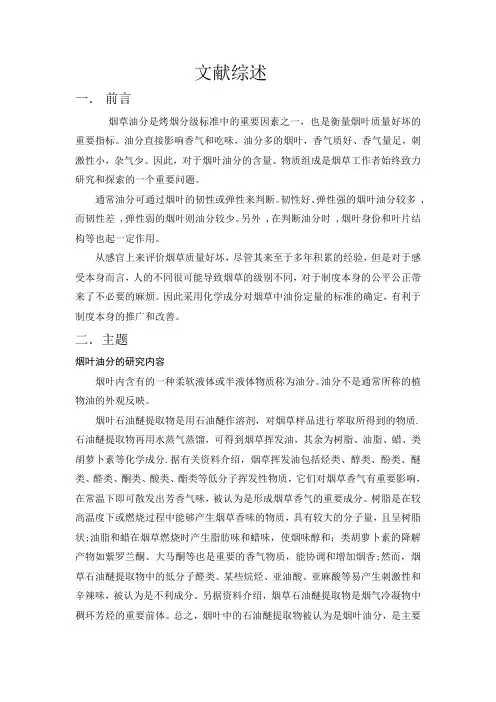
文献综述一.前言烟草油分是烤烟分级标准中的重要因素之一,也是衡量烟叶质量好坏的重要指标。
油分直接影响香气和吃味,油分多的烟叶,香气质好、香气量足,刺激性小,杂气少。
因此,对于烟叶油分的含量、物质组成是烟草工作者始终致力研究和探索的一个重要问题。
通常油分可通过烟叶的韧性或弹性来判断。
韧性好、弹性强的烟叶油分较多 ,而韧性差 ,弹性弱的烟叶则油分较少。
另外 ,在判断油分时 ,烟叶身份和叶片结构等也起一定作用。
从感官上来评价烟草质量好坏,尽管其来至于多年积累的经验,但是对于感受本身而言,人的不同很可能导致烟草的级别不同,对于制度本身的公平公正带来了不必要的麻烦。
因此采用化学成分对烟草中油份定量的标准的确定,有利于制度本身的推广和改善。
二.主题烟叶油分的研究内容烟叶内含有的一种柔软液体或半液体物质称为油分。
油分不是通常所称的植物油的外观反映。
烟叶石油醚提取物是用石油醚作溶剂,对烟草样品进行萃取所得到的物质.石油醚提取物再用水蒸气蒸馏,可得到烟草挥发油,其余为树脂、油脂、蜡、类胡萝卜素等化学成分.据有关资料介绍,烟草挥发油包括烃类、醇类、酚类、醚类、醛类、酮类、酸类、酯类等低分子挥发性物质,它们对烟草香气有重要影响,在常温下即可散发出芳香气味,被认为是形成烟草香气的重要成分。
树脂是在较高温度下或燃烧过程中能够产生烟草香味的物质,具有较大的分子量,且呈树脂状;油脂和蜡在烟草燃烧时产生脂肪味和蜡味,使烟味醇和;类胡萝卜素的降解产物如紫罗兰酮、大马酮等也是重要的香气物质,能协调和增加烟香;然而,烟草石油醚提取物中的低分子醛类、某些烷烃、亚油酸、亚麻酸等易产生刺激性和辛辣味,被认为是不利成分。
另据资料介绍,烟草石油醚提取物是烟气冷凝物中稠环芳烃的重要前体。
总之,烟叶中的石油醚提取物被认为是烟叶油分,是主要的致香物质。
研究表明,烟叶醚提物含量与烟叶的总体质量相一致,醚提物含量高的烟叶一般有利于使烟叶品质的化学成分含量丰富且比例协调,色度饱满,光泽强,油分多,弹性好,香气纯正丰满,吃味醇和舒适,劲头适中,综合质量最佳。
本氏烟草(N. benthamian)瞬时表达及相关实验方法:一、二、农杆菌介导的烟草瞬时转化:A、实验步骤:1、根据实验需要,将所要表达的基因克隆到含有不同标签的双元载体中,并转化农杆菌。
2、将新活化的农杆菌单克隆接种到含有相应抗生素的YEP中,28℃,200rpm过夜。
*估算时间,防止农杆菌液浓度超过1OD,否则会影响转化效率。
3、当菌液OD值介于0.6~1.0之间时,1000g,5min离心收集农杆菌。
4、用2ml Induction medium(without AS)轻柔重悬农杆菌,然后再次离心收集菌液。
5、重复步骤4。
6、所得沉淀用1ml Induction medium 重悬。
7、室温放置1~4小时8、测OD值,根据实验需要,配置侵染液(组合详见下文)。
9、用不加针头的注射器将侵染液注射进6~8周大的本氏烟草叶片中。
*使用注射器时注意安全,防止针头扎到手,使用完的注射器要把针头套套上再扔,或者将针头放到注射器里面,避免伤害他人;注射时应戴乳胶手套并在每次注射完成后清洗手套,防止交叉污染。
B、试剂:Induction medium:MES-KOH PH 5.710nMMgCl210mMAS 200uM推荐提前配制母液1M MES-KOH PH5.7 过滤灭菌,4℃保存,用时稀释100倍。
1M MgCl2过滤灭菌,4℃保存,用时稀释100倍。
0.2M AS 溶于DMSO 有机溶剂专用滤膜过滤灭菌,分装(避免反复冻融),-20℃。
用高压灭菌的超纯水稀释。
C、关于表达时间:烟草瞬时表达系统中蛋白的表达可以维持比较长的时间,一般注射24小时之后到一周之内都会有表达。
严格来讲需要摸索每个蛋白的最佳表达时段,但一般注射后48小时至72小时不同蛋白表达量都比较可观,不要错过。
D、关于侵染液浓度:推荐每个菌株的浓度在0.1~0.2之间。
过高的农杆菌浓度会。
在烟草中瞬时表达迷迭香酸的研究梁童瑶;邢丙聪;张治海;麻鹏达;梁宗锁;韩蕊莲【摘要】遗传转化一直以来都是研究药用植物次生代谢物调控的重要手段,虽然具有重现性好的优势,但获得稳定转化的毛状根体系或转基因植株往往费时费力,该方法无法满足大批量药用植物次生代谢调控相关基因的研究需求.农杆菌介导的瞬时转化以其易操作、低成本、短周期的优势,已被广泛应用于植物功能基因的研究中.然而目前药用植物的功能基因研究还常使用稳定遗传转化,或一些高成本、高难度的瞬时转化方法(如基因枪、原生质体转化等).因此,本研究利用pEAQ载体在本氏烟草叶片中高效表达了一个或多个外源基因,这将为外源基因在烟草中快速有效的表达提供新途径,也为进一步探究其功能提供了一条思路.多个外源基因的高效共表达也为在本氏烟草中异源构建次生代谢途径提供了可能.【期刊名称】《西北林学院学报》【年(卷),期】2017(032)001【总页数】5页(P179-183)【关键词】瞬时转化;烟草;pEAQ;异源代谢;迷迭香酸【作者】梁童瑶;邢丙聪;张治海;麻鹏达;梁宗锁;韩蕊莲【作者单位】西北农林科技大学生命科学学院,陕西杨陵712100;中国科学院水利部水土保持研究所,陕西杨陵712100;陕西省安塞县果业发展局,陕西安塞717499;西北农林科技大学生命科学学院,陕西杨陵712100;西北农林科技大学生命科学学院,陕西杨陵712100;中国科学院水利部水土保持研究所,陕西杨陵712100;西北农林科技大学生命科学学院,陕西杨陵712100;中国科学院水利部水土保持研究所,陕西杨陵712100【正文语种】中文【中图分类】S572瞬时转化系统已经成为可以替代稳定转化的一种手段[1]。
根癌农杆菌(Agrobacterium tumefacien)是植物遗传转化的常用工具,因其具有低成本、易操作、成功率高的优点,已应用于包括基因表达检测、基因沉默、亚细胞定位、蛋白互作分析、抑制子功能鉴定等多种研究当中[2]。
采⽤本⽒烟草瞬时表达系统进⾏蛋⽩质免疫共沉淀实验Protein Immunoprecipitation Using Nicotiana benthamiana Transient ExpressionSystemFang Xu*, Charles Copeland and Xin LiDepartment of Botany and Michael Smith Laboratories, University of British Columbia, Vancouver, Canada*For correspondence: xufang6185737@/doc/f911361831.html[Abstract] Nicotiana benthamiana (N. benthamiana) is a useful model system to transiently express protein at high level. This protocol describes in detail how to transiently express protein in N. benthamiana and how to carry out protein immunoprecipitation in this expression system. This protocol can be broadly used for investigation on protein-protein interaction, protein purification and other related protein assay.Materials and Reagents1. Nicotiana benthamiana seeds2. Agrobacterium strains harboring binary vector (e.g. pCambia1300, pBIN19) with thetargeted gene fused with protein purification tagNote: In this protocol, we use 3x FLAG tag as an example.3. Acetosyringone (Sigma-Aldrich, catalog number: D134406)4. MES (pH5.6) (Sigma-Aldrich, catalog number: M8250)5.ProteaseInhibitor(Roche,catalognumber************)6. Nonidet P 40 substitute (Fluka, catalog number: 74385)7. Induction medium (see Recipes)8. Infiltration solution (see Recipes)9. Extraction buffer (see Recipes)10. TBS (see Recipes)11. 4x SDS (see Recipes)Equipment1. Anti-FLAG beads (Sigma-Aldrich, catalog number: A2220)2. 3x FLAG peptides (Sigma-Aldrich, catalog number: F3290)3. Protein G sepharose beads (GE healthcare, catalog number: 17-0618-01)4. Test tubes, flask and shaker machine for culturing Agrobacterium5. Centrifuge6. 1 ml blunt syringe (BD, catalog number: 309659)Procedure1. Grow Nicotiana benthamiana at 22 °C (16 h day/ 8h night) to the age of 4 weeks. GrowAgrobacterium strains harboring binary vector with the targeted gene fused with 3x FLAG overnight at 28 °C at 200 rpm in 3 ml LB with proper antibiotic selection. With a sterilized pipette tip, inoculate a tiny amount of Agrobacterium glycerol stock into the test tube.2. Prepare induction medium and inoculate agrobacterium from the LB medium into theinduction medium. (1/100 dilution for overnight culture or 1/25 for about 8 h culture).This can be done in the morning to prepare for an evening infiltration, or at night to prepare for infiltration the next morning. 3. Incubate at 28 °C, with shaking at 200 rpm, for ~8-12 h, so that Agrobacterium cell isin the log growth phase. The best OD value should be 0.6-0.8.4. Centrifuge Agrobacterium culture in 50 ml Falcon tube for 10 min at 3,200 x g to pelletthe cells.5. Prepare infiltration solution.6. Resuspend Agrobacterium pellet in ~5-10 ml of infiltration solution.7. Measure the OD of Agrobacterium cells and add appropriate amounts of infiltrationsolution to dilute the Agrobacteria to the desired OD (usually 0.1-0.3 OD). Make at least 1 ml infiltration solution per leaf. If you want to co-express two or multiple proteins, mix different kinds of Agrobacteria, with the desired OD for each one. It’s recommended to carry out preliminary expression experiment to test the protein expression level for different constructs. You can adjust the OD value for each kind of Agrobacteria based on its protein expression level in N. benthamiana. For instance, you can use larger OD value for Agrobacteria expressing lower protein while use smaller OD value for Agrobacteria expressing abundant protein.8. Water the N. benthamiana plants about 30 min before the infiltration to make theinfiltration easier.9. Choose the proper leaves for infiltration. Choose the healthiest looking plants, andavoid leaves that are torn or otherwise damaged. The ideal leaves are the young leaves, ~3-5 cm across, use 2-3 leaves per plant. One leaf is about 0.1 g of tissue, which is enough for measuring protein expression. For immunoprecipitation, 10 leaves are usually enough.10. Use a 1 ml blunt syringe to inject the solution into the underside of the leaf. Swirl thesolution in the tube before drawing it up into the syringe, in order to evenly suspend the agrobacterium. Try to be as gentle as possible when injecting, to avoid damaging the leaf. The infiltrated area can easily be seen as a dark, water-soaked region. If the infiltrated region stops expanding without pushing too hard, infiltrate again in a different area of the leaf. There is no specific requirement for the infiltration regions as long as the infiltration can cover the leaf. Try to finish the infiltration using less than 5of N. benthamiana:https:///doc/f911361831.html/watch?v=GHc7PU_jG2M.After infiltration, the plants can be grown at the same condition as before.11. Harvest the N. benthamiana leaves without the main vein at 36-48 h afteragrobacterium infection. 1 g tissue usually is enough. Time point experiment might need to be carried out to decide at which time point the protein express the highest.12. Grind the tissues into a fine powder in liquid nitrogen using a cold mortar and pestle.13. Add extraction buffer [see Recipes, with 2% PVPP (polyvinylpolypyrolidone), 10 mMDTT, 1x protease inhibitor (PI) and 1 mM PMSF] into the mortar (2 ml extraction buffer per gram plant tissue), place it in the 4°C fridge, wait until the powder start to thaw and homogenize the mixture by grinding.14. Transfer all the liquid into the 1.5 tubes and centrifuge at highest speed for 10 min at4 °C.15. Transfer the supernatant into new tubes and centrifuge for another time.16. Transfer the supernatant into the tubes and add 20% NP40 to a final concentration of17. Add 20 µl protein G sepharose beads into the sample and incubate for 30 min in thecold room to pre-clear the sample (the beads were pre-equilibrated using 1 ml extraction buffer and the supernatant buffer was discarded after centrifugation at 12,000 x g for 30 sec).18. Pellet the beads by centrifugation at 12,000 x g for 30 sec and transfer the supernatantinto new tubes. 60 µl of the supernatant is taken as the input sample, which stands for the sample before immunoprecipitation.19. Add 10 µl anti-FLAG beads into the supernatant. The beads also need to beequilibrated as shown in step 18. Incubate the beads at 4 °C for 3 h on an Eppendorf tube rotator.20. Pellet the beads by centrifugation and take 60ul of supernatant for flow-throughsample.21. Wash the beads with 1 ml extraction buffer (with 0.15% NP40) for 3 times. For eachwashing step, pellet the beads by centrifuging at 12,000 x g for 1 min at 4 °C, discard the supernatant and add 1 ml extraction buffer.22. Add 100 µl diluted 3x FLAG peptide (dilute the 3x FLAG stock 1/10 in TBS containing1 mM EDTA with 1x protease inhibitor. The 3x FLAG stock is 2.5 mg/ml in TBS whichcan stored at -20 °C for years) into the beads and incubate in the cold room for 1 h on an Eppendorf tube rotator.23. Pellet the beads by ce ntrifugation. Transfer the supernatant into a new tube. Add 35 µl4x SDS loading buffer into the supernatant. This fraction is the elution sample containing the purified immunoprecipitated protein. Add 60 µl 1x SDS loading buffer into the tube containing the beads. The beads sample might contain the residue protein that fails to elute from the beads.Boil all the samples at 95-100 °C for 5-10 min. And analyze the samples using Western blot.Representative dataA representative experiment result was shown in the Figure 1. The figure was adaptedfrom the Xu et al. (2014) as listed in the reference.Figure 1. bHLH84-HA co-immunoprecipitates with SNC1-FLAG. Two samples were used in the Co-IP experiment including sample with coexpression of bHLH84 and SNC1-FLAG and sample with expression of only bHLH84, which serves as the negative control.Notes1. Negative control samples are always recommended during the immunoprecipitationprocess. For immunoprecipitation of single protein, it is suggested to express theempty vector to serve as the negative control. For co-immunoprecipitation of two ormore proteins, it is suggested to express the empty vector without the bait proteintogether with the relative vectors containing the prey proteins. Based on theexperiment design, more negative controls can be included accordingly.2. As long as the protein can be pulled down, the immunoprecipitation experiment ishighly reproducible although the IP efficiency might be vary slightly in different trials.1. Induction mediumNote:You also need to add proper antibiotics to the following media.Reagent Stockconcentration SterilizationVolume/100 mlFinalconcentrationK2HPO410.5 g/L Mix alltogetherwith waterand autoclave 96.85 mlKH2PO4 4.5 g/L(NH4)2SO4 1.0 g/LNaCitrate:2H2O 0.5 g/LGlycerol 0.5%Glucose 20% Filter 1 ml 0.2% MgSO4 1 M Filter 100 µl 1 mM Acetosyringone 100 mM Filter 50 µl 50 µl MES (pH 5.6) 0.5 M Filter 2 ml 10 mM2. Infiltration solutionReagent Stockconcentration Sterilization Amount per20 mlFinalconcentrationMS powder NA 0.088 g 4.4 mg/LMES 0.5 M Filter 0.4 ml 10 mMAcetosyringone 100 mM Filter 30 µl 150 µM3. Extraction buffer10% glycerol25 mM Tris-HCl (PH 7.5)1 mM EDTA150 mM NaCl10 mM Tris-HCl150 mM NaCl (PH 7.4)5. 4x SDS200 mM Tris-HCl (PH 6.8)8% SDS40% glycerol0.04% bromophenol blue400 mM DTTAcknowledgmentsWe are grateful for the financial supports from Natural Sciences and Engineeringexpression in N. benthamiana was adapted from Van den Ackerveken et al. (1996). The IP protocol was modified from Moffett et al. (2002).References1. Moffett, P., Farnham, G., Peart, J. and Baulcombe, D. C. (2002). Interaction betweendomains of a plant NBS-LRR protein in disease resistance-related cell death.EMBO J 21(17): 4511-4519.2. Van den Ackerveken, G., Marois, E. and Bonas, U. (1996). Recognition of thebacterial avirulence protein AvrBs3 occurs inside the host plant cell.Cell 87(7):1307-1316.3. Xu, F., Kapos, P., Cheng, Y. T., Li, M., Zhang, Y. and Li, X. (2014). NLR-associatingtranscription factor bHLH84 and its paralogs function redundantly in plant immunity.PLoS Pathog 10(8): e1004312.。
本科生毕业设计(论文)( 2015届)农业与食品科学学院题目:烟草遗传转化体系的建立学号:姓名:专业班级:2015 年 5 月18 日本科生毕业设计(论文)诚信承诺书我谨在此承诺:本人所写的毕业设计(论文)《烟草遗传转化体系的建立》均系本人独立完成,没有抄袭行为,凡涉及其他作者的观点和材料,均作了引用注释,如出现抄袭及侵犯他人知识产权的情况,后果由本人承担。
承诺人(签名):年月日目录本科生毕业设计(论文).............................................................................................. 封1 本科生毕业设计(论文)诚信承诺书...................................................................................... 封2 1 前言. (1)1.1 农杆菌介导法 (1)1.2 基因枪法 (2)1.3 PEG法 (2)1.4 显微注射法 (2)2 材料与方法 (3)2.1 试验材料 (3)2.1.1 植物材料 (3)2.1.2 菌株和质粒 (3)2.2 试验方法 (3)2.2.1 农杆菌的制备 (3)2.2.2 叶片表面消毒 (3)2.2.3 预培养-侵染-共培养 (4)2.2.4 特美汀对农杆菌的抑制作用 (4)2.2.5 芽分化-卡那霉素浓度的测定 (4)2.2.6 根分化 (5)2.2.7 炼苗-移栽 (5)2.2.8 转基因植株的分子鉴定 (5)3 结果与分析 (6)3.1 农杆菌菌液侵染时间对转化效率的影响 (6)3.2 共培养时间对转化率的影响 (7)3.3 特美汀对根瘤农杆菌的抑菌效果 (7)3.4 卡那霉素浓度对烟草叶片外植体出愈率的影响 (8)3.5 转基因植株的分子鉴定 (8)4 讨论 (9)参考文献 (9)致谢 (11)烟草遗传转化体系的建立农业与食品科学学院农学111 吴春盛指导教师:郑志富摘要:利用农杆菌介导的转化法获得转基因植物,这是研究目的基因功能的一种有效方法。
Systemic Agrobacterium tumefaciens–mediated transfection of viral replicons for efficient transient expression in plantsSylvestre Marillonnet 1,2,Carola Thoeringer 1,2,Romy Kandzia 1,Victor Klimyuk 1&Yuri Gleba 1Plant biotechnology relies on two approaches for delivery and expression of heterologous genes in plants:stable genetictransformation and transient expression using viral vectors.Although much faster,the transient route is limited by low infectivity of viral vectors carrying average-sized or large genes.We have developed constructs for the efficient delivery of RNA viral vectors as DNA precursors and show here that Agrobacterium–mediated delivery of these constructs results in gene amplification in all mature leaves of a plant simultaneously (systemic transfection).This process,called ‘magnifection’,can be performed on a large scale and with different plant species.This technology combines advantages of three biological systems (the transfection efficiency of A.tumefaciens ,the high expression yield obtained with viral vectors,and the post-translational capabilities of a plant),does not require genetic modification of plants and is faster than other existing methods.Viral vectors designed for expression of recombinant proteins in plants hold great promise because of high absolute and relative yields,and because of the speed provided by transient expression.Most of the results of practical interest achieved so far have been obtained with vectors built on the backbones of plus-sense RNA viruses such as tobacco mosaic virus (TMV)or potato virus X 1–4.We have recently shown that TMV-based vectors can be delivered to plant tissues using A.tumefaciens 5(agroinfection).However,one step of this process,namely the formation of active replicons from the primary nuclear transcript,is inefficient.In a standard leaf transfec-tion experiment,this inefficiency is masked by the subsequent ability of the replicons to move to neighboring cells by cell-to-cell movement.Here we show that this bottleneck can be fully remedied by incorpora-tion of silent nucleotide substitutions into the vector and by addition of multiple introns.We demonstrate that such modifications provide for efficient processing of the DNA information into active replicons in almost all cells (as high as 94%)of Nicotiana benthamiana ,an up to 1,000-fold improvement over nonoptimized TMV-based vectors,and an even higher improvement (4106-fold)in Nicotiana tabacum (tobacco).Finally,we show that the resulting vectors allow the development of a fully scalable and versatile whole-plant transfection protocol,that we term magnifection,for production of heterologous proteins in plants.RESULTSViral replication following agroinfiltration of TMV-based vectors Agroinfiltration of a TMV-based viral vector containing the gene encoding green fluorescent protein (GFP)(pICH16707,Fig.1a )into N.benthamiana leaves leads to the formation of foci of GFPfluorescence 3d post-infiltration (d.p.i.)(shown in ref.5and in Supplementary Fig.1online).T o quantify the proportion of cells initiating viral replication,a 489-bp deletion was made within the movement protein (MP)coding sequence,resulting in construct pICH14833(Fig.1a ).Replicons derived from this construct cannot move from cell-to-cell but are able to replicate autonomously within each infected cell.Three days after agroinfiltration of pICH14833in N.benthamiana leaf (OD 600of the A.tumefaciens in infiltration solution was 0.7),a small number of cells expressing GFP appeared (see Supplementary Fig.1online),and the same pattern was still visible 2weeks after infiltration.By counting protoplasts prepared from the infiltrated area (Figs.1and 2),we found that 0.6–1.6%of cells initiated viral replication.There are several reasons why RNA viral vectors might have difficulties starting the replication cycle.First,RNA viruses,such as TMV ,replicate in the cytoplasm and never enter the nucleus,and have therefore evolved in an environment where they are not exposed to the nuclear pre-mRNA processing machinery.As a result,pre-mRNA transcripts made in the nucleus from viral constructs may not be re-cognized and processed properly.Second,viral vector constructs encode very large transcripts (B 7.6kb for the primary transcript of a viral vector containing a GFP gene),a size much larger than the average size (1–2kb)of plant genes.Moreover,in nature,large eukaryotic genes often contain numerous introns that facilitate processing and export of the pre-mRNAs from the nucleus 6.We therefore hypothesized that modifications of the constructs that would increase the efficiency of processing and export of primary transcripts from the nucleus to the cytoplasm could lead to an increase in the number of cells that would initiate viral replication.Two types of modifications were made:Published online 8May 2005;doi:10.1038/nbt10941IconGenetics,Biozentrum Halle,Weinbergweg 22,D-06120Halle (Saale),Germany.2These authors contributed equally to this work.Correspondence and requests for materials should be addressed to Y.G.(gleba@icongenetics.de).A R T I C L E S©2005 N a t u r e P u b l i s h i n g G r o u p h t t p ://w w w .n a t u r e .c o m /n a t u r e b i o t e c h n o l o g y(i)removal of sequence features that might be improperly recognized by the RNA processing machinery (such as cryptic splice sites and thymine-rich intron-like sequences),and (ii)addition of introns.Removal of putative intron-like featuresT o identify sequence features that might induce abnormal RNA processing events,we analyzed the sequence of pICH14833using the NetgeneII program (http://www.cbs.dtu.dk/services/NetGene2/(ref.7))with parameters set for Arabidopsis thaliana sequences.We noticed several intron-like sequence features consisting of putative cryptic splice sites and several thymine-rich sequences (see Supple-mentary Fig.2online).We first removed some of the putative cryptic splice sites by using PCR with primers designed to introduce silent nucleotide substitu-tions.However,the resulting constructs (pICH15011and pICH17266)were not significantly more efficient than the initial construct,pICH14833(Fig.1and Supplementary Table 1online).Then,we mutagenized a 0.6-kb thymine-rich region located at the beginning of the RdRp coding sequence by introducing 54silent nucleotide sub-stitutions (two substitutions being the two splice site mutations also present in pICH15011)to increase its GC content.The resulting clone,pICH15466,worked substantially better than the unmodified clone,with 13%of cells in the infiltrated area initiating viral replication (Fig.1)compared to 1.6%for pICH14833.Another potentially problematic region corresponds to a 220-bp thymine-rich sequence at the 3¢end of the RdRp coding sequence,a region that contains the MP subgenomic promoter (see Supplementary Fig.2online).Forty-three silent nucleotide substitutions were introduced in this area (leaving all other regions unmodified).With the resulting construct,pICH15900,53%of cells from the infiltrated area expressed GFP (Fig.2b ,Fig.2e infiltration 4).In a separate assay,we measured the amount of GFP fluorescence in the infiltrated area,and found an increase from 3.3fluorescence units (for pICH14833)to 53.3,a relative increase consistent with the increase in the number of GFP-expressing protoplasts.A construct similar to pICH15900but with no deletion in the MP ,pICH16989,gave similar rates of initiation of replication,indicating that the improvement was due to modification of the codon usage and not to the deletion in the MP (Fig.1).T o test whether these modifications had an effect on viral replica-tion,pICH15466and pICH15900were infiltrated into the leaves of transgenic N.benthamiana plants expressing MP (plants transformed with pICH10745).The size of the GFP-expressing foci and the intensity of GFP fluorescence appeared similar for both constructs and pICH14833(Fig.2f ),showing that modification of the RNA sequence did not significantly affect the replication or cell-to-cell movement abilities of the viral vector.pICH15025 pICH15034pICH16877pICH15488pICH15755pICH15477 pICH17200 pICH15922 pICH15499pICH16433 pICH14030 pICH15041pICH16100pICH16191pICH16200 pICH15860 pICH16141pICH17494 (pICH16707)pICH18535(pICH18000)pICH18722(pICH18711)pICH17466 (pICH16424)pICH17474(pICH17272)pICH18523(pICH17282) pICH15466 pICH15900pICH17266 pICH15011 pICH14833 pICH16989pICH5661(pICH15662)pICH17144pICH18000pICH17272abFigure 1Constructs maps and quantificationof the efficiency of initiation of replication.(a )Schematic representation of the constructs.The MP is shown as a gray box between the TVCV RNA-dependent RNA polymerase (RdRp)and the GFP coding sequence.Deletions of 489and 575nt are labeled d1and d2,respectively.Introns are shown as narrow white boxes,and the designation of the insertion sites (numbered 1–23,position given in the methods section)are indicated by a number above the introns.1a and 1b refer to the insertion of two different introns at the sameposition (position 1).Vertical black lines show the position of mutated putative splice sites.Two mutagenized regions containing 54and 43silent nucleotide substitutions are shown as a gray box underlined with a black line,and as a dotted box,respectively.A frameshift in the MP is shown as an X at the beginning of the MP .Construct numbers written in italics under construct names correspond to versions of the constructs not containing a frameshift in the MP .Act2,A.thaliana ACT2promoter;N,cr-TMV 3¢untranslated region;T,Nos terminator.(b )Quantification of the efficiency of initiation of replication of viral constructs measured by counting the proportion of protoplasts expressing GFP in infiltrated areas (gray columns,expressed as a percentage of all protoplasts)or bymeasuring GFP fluorescence with a luminescence spectrometer (black columns,expressed influorescence units,all values were multiplied by 0.7in order to be visualized on the same scale as the protoplast counts).Error bars indicate standard deviation.For protoplasts counts,two samples of 400–500protoplasts were counted from each protoplast preparation.For GFPfluorescence,values were determined from three samples taken from different infiltrated leaves.A R T I C L E S©2005 N a t u r e P u b l i s h i n g G r o u p h t t p ://w w w .n a t u r e .c o m /n a t u r e b i o t e c h n o l o g yAddition of intronsNext,introns were added at up to 19positions within the RdRp and the MP sequences.When introns were inserted into the MP coding sequence,the MP was made nonfunctional by a frameshift rather than by a deletion.The presence of most introns increased the efficiency of initiation of viral replication,although some introns were not as effi-cient as others (Fig.1b ).Insertion of additional introns usually further increased the efficiency of initiation of viral replication.For example,with pICH18535,which contains 12introns,92%(90–94%)of protoplasts from the infiltrated area expressed GFP .With the same construct (but with a functional MP),pICH18000,93%(90–96%)of protoplasts expressed GFP .This suggests that with constructs with more than 12introns,initiation of viral replication starts in virtually every N.benthamiana cell,at least when infiltration solution containing agrobacteria at an OD 600of 0.7is used.Also,at the protein level,expression of GFP was similar in 16-intron constructs with or without a functional MP (pICH18711-described below,and pICH18722,Fig.2g ).We also tested the effect of the presence of introns within the gene of interest.Four introns were inserted within the GFP coding sequence,resulting in construct pICH17144.This construct worked better than the same construct without introns,with 9.5%of cells in the infiltrated area expressing GFP .Viral replication of fully-optimized viral vectorsWe then tested the performance of pICH18711,a fully optimized construct containing most of the modifications described above (the first mutagenized region at the beginning of the RdRp and 16introns in the RdRp and MP coding sequences),but also containing a functional MP (Fig.1a ).A dilution series of A.tumefaciens in infiltration solution was infiltrated into N.benthamiana and tobacco leaves (Fig.3a ,b ).Whereas no GFP-expressing sector could be detected with the original construct in N.benthamiana at dilutions higher than 10À3,GFP-expressing foci were obtained until the 10À6dilution with pICH18711.Infiltration of a 10À4dilution for pICH18711gave a similar number of GFP-expressing foci as the 10À1dilution for the nonoptimized construct,pICH16707,indicatinga 1,000-fold increase in the efficiency of initiation of viral replication.The number of bacteria present in each dilution was estimated by plating an aliquot of the infiltration solution and counting the number of colonies for the 10À5and 10À6dilutions.This showed that approximately eight A.tumefaciens cells are required perGFP-expressing event in N.benthamiana ,whereas 5,700agrobacteria are required for the unmodified control construct.This represents a 712-fold improvement,in accordance with the 1,000-fold increase cited above.For tobacco,23agrobacteria were required per GFP-expressing foci.In contrast,a nonoptimized construct did not work properly in tobacco,even at high bacterial concentration:at the 10À1and 10À2dilutions,only a few individual cells in the infiltrated area expressed GFP ,but replicons were unable to move outside of these few initial cells.Optimized viral vectors were also tested in N.excelsior,and the same level of improvement was seen as in N.benthamiana .Characterization of the optimized viral vectorsWe replaced the relatively small GFP coding sequence (0.7kb)in pICH16707and pICH18711by the larger coding sequence (1.8kb)of the b -glucuronidase gene (GUS),resulting in constructs pICH18841(0introns)and pICH18851(16introns),respectively.With pICH18841,fewer replication foci were observed in infiltrated areas than when using a construct expressing GFP (not shown),suggesting that longer genes may negatively affect the frequency of initiation of viral replication.By using the intron-optimized viral vector pICH18851,the entire infiltrated area was expressing GUS.A time-course experiment was carried out to measure the time required to obtain maximal gene expression after infiltration with either GFP -or GUS -containing constructs (Fig.3c ,d ).A 10À1dilutionea b c d1234681112fu gFigure 2Performance of different synthetic vectors.(a –d )Protoplastsprepared from N.benthamiana leaves with pICH14833(a ),pICH15900(b ),pICH18722(c )and pICH18711(d ),photographed under blue light.Scale bar,100m m.(e )N.benthamiana leaves were infiltrated with pICH14833(1),pICH15011(2),pICH15466(3),pICH15900(4),pICH15477(5),pICH15034(6),pICH16433(7),pICH16141(8),pICH17466(9),pICH17144(10),pICH18722(11),pICH18711(12)and photographed under UV light at 7d.p.i.Infiltrations 13–15were similar to infiltrations 10–12except that pICH10745was coinfiltrated to provide transient MP expression.Infiltrations in a –e were performed with A.tumefaciens in infiltration solution at an OD 600of 0.7.(f )Leaf of a transgenic N.benthamiana plant (pICH10745)infiltrated with pICH14833(1),pICH15466(2)and pICH15900(3).A.tumefaciens infiltration solutions were diluted to between 10À3to 10À4relative to the overnight-grownA.tumefaciens culture in order to obtain separate GFP foci.(g )Coomassie-stained SDS protein gel loaded with crude extracts prepared fromN.benthamiana noninfiltrated leaf tissue (u)or from the infiltrated areas shown in e (numbering is as in panel e ).Molecular weights (kDa)are shown on the left.The arrow indicates GFP .A R T I C L E S©2005 N a t u r e P u b l i s h i n g G r o u p h t t p ://w w w .n a t u r e .c o m /n a t u r e b i o t e c h n o l o g yof the A.tumefaciens infiltration solution (OD 600¼0.35)was used for this experiment.For both GFP and GUS,levels of expression increased faster and reached higher levels with intron-containing constructs.As a control for transient expression using nonreplicating constructs,a time course was performed for GFP expressed from the CaMV 35S promoter (pICH5290)in the absence or presence of the suppressor of silencing p19to enhance expression 8(Fig.3c ).In both cases,GFP expression levels were lower than with viral vectors.Transfection of whole plants:‘magnifection’Since TMV-based vectors that lack a coat protein gene cannot move systemically,production in entire plants requires inoculating all leaves of a plant.However,this process is inefficient with unimproved viral vectors owing to low infectivity of the vectors.Having improved viral vectors in hand,we attempted to inoculate entire plants using a variety of treatments,including immersing or spraying entire plants,applying (or not)a vacuum treatment,infiltrating whole plants or detached leaves,wilting plants/leaves before treatments,using detergents and solubilizers.The best and most reliable results were obtained by simply immersing all aerial parts of an entire plant into a bacterial suspensionand applying a weak vacuum (0.5–1bar)for 1–2min,followed by a gentle (o 1min)gradual return to atmospheric pressure.This simple procedure,which is similar to a protocol commonly used for transientexpression in detached leaves 9,leads to infiltration of A.tumefaciens suspension into the intercellular space of all mature leaves of tobacco or N.benthamiana plants.The treated plants are then simply returned to the greenhouse (under standard conditions)where they fully recover.This procedure leads to GFP expression in all leaves,with the exception of the young nonexpanded leaves of the apex (Fig.4).The infiltration procedure was tested on plants and seedlings of different ages,ranging from 2weeks old to flowering age (6–8weeks depending on growth conditions).High levels of GFP expression were obtained in the mature leaves of all plants,but a higher ratio of expressing to nonexpressing tissue was obtained for larger plants (43weeks old).High levels of GFP expression were also obtained with plants infiltrated at flowering stage,although at later stages,older leaves showed reduced expression.We also tested bacterial suspensions that were diluted 10À1to 10À6relative to a saturated overnight bacterial culture (OD 600of the 10À1dilution was 0.35or B 1.8Â108colony forming units per ml).Infiltrations were performed with N.benthamiana and N.tabacum plants.For both species,the 10À3dilution provided the highest yield,indicating that the 10À1and 10À2dilutions are somewhat inhibitory or toxic to plant cells (Fig.5).For the 10À3or lower dilutions,development of the infection was delayed,indicating that the primary infection by agrobacteria occurred in a minority of cells only,and thatc d.p.i.d.p.i.Figure 3Efficiency of ‘agrodelivery’and of gene expression of the final,fully optimized construct.(a )Tobacco leaf infiltrated with dilution series ofA.tumefaciens in infiltration solution for constructs pICH16707(lower half of the leaf)and pICH18711(upper half).Dilutions labeled –1to –6correspond to 10À1to 10À6dilutions of the A.tumefaciens relative to the starting overnight culture (OD 600of the 10À1dilution was 0.35).The picture was taken under UV light at 9d.p.i.(b )Same as in a but in N.benthamiana.The picture was taken at 5d.p.i.(c )Time course showing the level of GFP fluorescence in N.benthamiana leaf from 2or 3to 10d.p.i.All samples from individual curves were harvested from the same leaf.Leaves A and B were infiltrated with pICH18711,leaves C and D with pICH16707,leaf E with pICH5290(35S-GFP )and leaf F with pICH5290+pICH6692(35S-p19);A.tumefaciens concentration was at 0.35under OD 600for all infiltrations.f.u.,fluorescence units.(d )As in c but with GUS fluorescence by infiltration of pICH18851(16introns)in leaves A and B and pICH18841(0intron)in leaves C and D.Figure 4Expression of GFP in N.benthamiana plants and Beta vulgaris .Whole plants were vacuum-infiltrated with pICH18711and viewed under UV light.(a –d )N.benthamiana plants 4d after infiltration with infiltration solution containing agrobacteria diluted 10À1(d ),10À2(c ),10À3(b )or 10À4(a )relative to the overnight saturated A.tumefaciens culture (OD 600¼0.35of the 10À1dilution).(e )N.benthamiana plants of various ages (17–35d after sowing)wereinfiltrated with a 10À1diluted infiltration solution and photographed 4d later.(f )same plant as shown in e )(infiltrated 28d after sowing),but pictured 6d.p.i.(g ,h )Beta vulgaris var.conditiva vacuum-infiltrated with pICH18711(A.tumefaciens OD 600¼0.35),photographed under normal (g )or UV light (h )10d.p.i.A R T I C L E S©2005 N a t u r e P u b l i s h i n g G r o u p h t t p ://w w w .n a t u r e .c o m /n a t u r e b i o t e c h n o l o g y(virally controlled)cell-to-cell spread of the replicons was then required to complete transfection of all leaf tissue.The absolute protein yield seen in our experiments was as high as 4g of recombinant protein per kg of fresh leaf biomass in N.benthamiana and up to 2.5g/kg in tobacco (N.tabacum),and the relative yield as high as 25%and 40%of total soluble protein in both species,respectively (Fig.5).Assuming such protein yield,and based on realistic yields of 100tons of plant leaf biomass per hectare of a greenhouse per year,a 1ha facility should be capable of producing 280–400kg of recombinant protein per year.Our measurements show that infiltration consumes 1–1.5liters of bacterial suspension per kg of plant leaf biomass,indicating that,at the optimal 10À3dilution,1liter of overnight A.tumefaciens culture is sufficient to treat 700–1,000kg of N.benthamiana biomass and to produce 2.5–4.0kg of recombinant protein.Analysis of magnifection in different plant speciesWhole-plant infiltration was tested on over 50dicotyledonous plant species belonging to eight plant families.Good expression was found in seven species (petunia,cucumber,sunflower,red beets,spinach,Chenopodium capitatum and Tetragonia expansa ),representing five plant families (expression in red beets shown in Figure 4).Some expression was also detected in six other species,including A.thaliana ,Brassica spp.and Lepidium sativum .Since the leaves of some species supporting the transfection,including red beets,spinach,Chenopo-dium or Tetragonia,can be used as uncooked food,the technology proposed here can in principle be used for manufacturing edible/topical vaccines or for production of minimally processed functional foods/feeds.DISCUSSIONThe first demonstration of A.tumefaciens –mediated infection of a plant with a TMV-based vector was reported in 1993(ref.10).The authors quantified the effectiveness of the process and concluded that for a wild-type TMV virus (the U1strain),transfection is very inefficient,requiring B 108bacteria for one successful infection event in a tobacco plant.Since agroinfection by DNA viruses is generally much more effective (103–105bacteria per event),the authors concluded that the low efficiency for RNA viruses is a result of either viral RNA degradation in the nucleus,premature termination of transcription,or low in vivo rates of transcription or poor transcript transport to the cytoplasm.The results of our study both support those conclusions and provide effective remedies,resulting in a process that requires 20bacteria to generate one transfection eventin a tobacco plant,an up to 107-fold improvement over the original process.Several investigators had previously modified the cDNA of RNA viruses by introduction of introns,but mainly with the goal of eliminating the toxicity caused by viral sequences in bacteria 11–13.The general principle of modifying a DNA copy of an RNA virus-derived replicon for increased infectivity is most likely also applicable to other cytoplasmic plant and animal RNA viruses other than the crucifer-specific TMV strain used in our experi-ments 14,15(see also ref.16).Having a more infectious viral vector allowed us to develop magnifection,an efficient whole-plant infiltration protocol.This straightforward protocol requires,in addition to well-established industrial upstream (plant cultivation)and downstream (protein extraction and purification)components,a simple technology block that contains an apparatus for vacuum-infiltration of batches of plants and a chamber/greenhouse for subsequent short-term incubation,as well as a small bacterial fermenter 17.Such a block would of course require certain safety locks so as to prevent the release of agrobacteria into the open environment and to protect the operating personnel.The magnifection process relies on vectors that do not express a coat protein.Although such vectors cannot move systemically,the combination with magnifection provides a solution that has many advantages over existing systems:(i)the vectors are less affected by transgene size since they do not have to move systemically;(ii)simultaneous infection of multiple cells in multiple leaves means that expression is more synchronous and faster;(iii)a larger propor-tion of the host plant is infected by the virus than with traditional vectors (which move systemically primarily to young emerging host tissue);(iv)all metabolic resources of the cell are directed toward synthesis of the protein and not wasted to make large amounts of coat protein;(v)replicon RNAs are not packaged into viral particles and therefore cannot be transferred to secondary untransfected plants or generate wild-type virus.The magnifection process described here is safe,since,in addition to the lack of of viral particle formation,the high yield achievable allows for full containment of the process,thus avoiding open field cultiva-tion.We have also shown that vectors lacking MP are fully comple-mented by host plants engineered to express this viral protein,and therefore using such vectors would lead to an even safer process (unpublished data).Finally,A.tumefaciens is a ubiquitous soil bacter-ium that,for industrial-scale applications,can be genetically rendered unable to survive in the natural environment 18or to transfer Ti plasmid via conjugation to other bacteria.Undesired DNA transfer can also be limited by deleting from the bacterial genome some10–110–3G F P (m g /g f r e s h w e i g h t )adm u 2456789101112s u3dpiFigure 5Time course of GFP expression in N.benthamiana and tobacco.(a )GFP in N.benthamiana plants infiltrated with pICH18711with infiltration solution diluted 10À1to 10À5relative to the overnight saturated A.tumefaciens culture,2–12d.p.i.(b)Coomassie-stained SDS gels loaded with crude protein extracts from N.benthamiana plants infiltrated with the 10À1and 10À3diluted infiltration solutions.m,molecular weight markers (94,67,43,30,20and 14kDa);u,uninfiltrated plant;s,GFP standard.(c )As in a ,but with tobacco.(d )As in b ,but with tobacco.A R T I C L E S©2005 N a t u r e P u b l i s h i n g G r o u p h t t p ://w w w .n a t u r e .c o m /n a t u r e b i o t e c h n o l o g yessential functions necessary for T-DNA transfer (from bacteria to plant host)and engineering the plant host to provide those in trans 19,20,or by mixing two agrobacteria that require intercellular complementa-tion for the transfer to occur (ref.21and unpublished data).METHODSConstructs.pICH16707is a GFP-expressing TMV-based viral vector derived from pICH4351(ref.5),but differs from this construct by lack of a LoxP recombination site and by a different vector backbone.pICH15011and pICH17266were made by mutating two putative splice sites (CG/G T GA to CG/G A GA,position 829relative to GenBank accession no.BRU03387,and GCA G /GA to GCA A /GA,position 1,459)or four putative sites (AA/G TAC to AA/A TAC,position 4,201;GC A G/CC to GC C G/CC,position 4411;AA/G TAT to AA/A TAT,position 4,570;AT A G/TC to AT C G/TC position 4,884),respec-tively.Several derivatives were also made from pICH16707by introducing 54and 43silent nucleotide substitutions in areas extending from nt 827to 1,462and 4,655to 4,871,respectively (numbering relative to GenBank accession no.BRU03387,Fig.1a ).The mutated areas were synthesized by PCR using overlapping oligonucleotides containing the desired modifications.Introns ranging in size from 91to 443nt were amplified from A.thaliana genomic DNA by PCR.Sites for intron insertion in the viral sequence were selected that either matched the consensus AG/GT or that could be mutated with silent nucleotide substitutions to match the consensus.Nineteen different positions (shown in Fig.1a )were selected (position given relative to turnip vein-clearing virus (TVCV)sequence,GenBank accession no.BRU03387):1,nt 209;2,nt 423;3,nt 828;4,nt 1,169;5,nt 1,378;6,nt 1,622;7,nt 1,844;8,nt 2,228;9,nt 2,589;10,nt 2,944;11,nt 3,143;12,nt 3,381;13,nt 3,672;14,nt 3,850;15,nt 4,299;16,nt 4,497;17,nt 5,099;18,nt 5,287;19,nt 5,444.Four insertion sites were also selected in GFP (positions given relative to the start of the ORF:20,nt 155;21,nt 275;22,nt 383;23,nt 490).The TVCV MP coding sequence was amplified by PCR from cloned TVCV cDNA (GenBank accession no.BRU03387,bp 4,802–5,628)and subcloned in pICBV10(a pBIN19-derived binary vector)under control of the 35S promoter,resulting in plasmid pICH10745.pICH6692contains the suppressor of silenc-ing p19amplified from tomato bushy stunt virus (TBSV)cDNA using primers 5¢-TTCCATGGAACGAGCTATACAAGGAAACG-3¢and 5¢-CGGGATCCTTAC TCGCTTTCTTCTTCGAAGGT-3¢and cloned under control of a 1.3kb 35S promoter fragment in pICBV10.pICH5290contains the gene encoding GFP 22under control of a 1.3-kb 35S promoter fragment in pICBV1(a pBIN19-derived binary vector).Infiltration of plants and protoplast isolation.Infiltrations of individual leaf sectors were performed as described 5.Agrobacteria were resuspended in infiltration solution at various dilutions relative to the overnight saturated A.tumefaciens culture,from a 5-fold dilution (OD 600¼0.7)to a 10À6dilution (see main text and figure legends).For inoculation of entire plants,Agrobacteria were inoculated to 300ml of Luria-Bertani medium containing 50m g/ml rifampicin and 50m g/ml kanamycin (selection for the binary vector)and grown at saturation.The bacteria were pelleted at 4,800g for 10min and resuspended in 3liters of infiltration buffer (10mM 2-[N -morpholino]ethanesulfonic acid (MES)pH 5.5,10mM MgSO 4)in order to get a 10À1dilution relative to the saturated A.tumefaciens culture or in a larger volume for higher dilutions.A beaker containing the infiltration solution was placed in a vacuum chamber (30-cm diameter),with the aerial parts of a plant dipped into the solution.A vacuum was applied for 2min using a Type PM 16763-860.3pump from KNF Neuberger,with pressure ranging from 0.5to 0.9bar.The plants were returned to the greenhouse under standard conditions.The protoplast isolation procedure is also as previously described 5.Quantification of GFP and GUS.GFP quantification was performed by spectrofluorometry as previously described 5.Absolute GFP proteinconcentration was determined by comparing values of the protein extracts to a standard curve made with recombinant GFP (rGFP from Roche,concentra-tion 1mg/ml).The GUS assay were performed using 50-mg leaf tissue samples according to the protocol described 23.Note:Supplementary information is available on the Nature Biotechnology website.ACKNOWLEDGMENTSWe thank Robert Erwin and Yuri Dorokhov for useful discussions.COMPETING INTERESTS STATEMENTThe authors declare competing financial interests (see the Nature Biotechnology website for details).Received 14December 2004;accepted 15March 2005Published online at /naturebiotechnology/1.Porta,C.&Lomonossoff,G.P .Viruses as vectors for the expression of foreign sequencesin plants.Biotechnol.Genet.Eng.Rev.19,245–291(2002).2.Pogue,G.P .,Lindbo,J.A.,Garger,S.J.&Fitzmaurice,W.P .Making an ally from anenemy:plant virology and the new agriculture.Annu.Rev.Phytopathol.40,45–74(2002).3.Gleba,Y.,Marillonnet,S.&Klimyuk,V.Engineering viral expression vectors for plants:the ‘full virus’and the ‘deconstructed virus’strategies.Curr.Opin.Plant Biol.7,182–188(2004).4.Mallory,A.C.et al.The amplicon-plus system for high-level expression of transgenes inplants.Nat.Biotechnol.20,622–625(2002).5.Marillonnet,S.et al.In planta engineering of viral RNA replicons:efficient assembly byrecombination of DNA modules delivered by Agrobacterium A 101,6852–6857(2004).6.Reed,R.&Hurt,E.A conserved mRNA export machinery coupled to pre-mRNAsplicing.Cell 108,523–531(2002).7.Hebsgaard,S.M.et al.Splice site prediction in Arabidopsis thaliana pre-mRNA bycombining local and global sequence information.Nucleic Acids Res.24,3439–3452(1996).8.Voinnet,O.,Rivas,S.,Mestre,P .&Baulcombe,D.An enhanced transient expressionsystem in plants based on suppression of gene silencing by the p19protein of tomato bushy stunt virus.Plant J.33,949–956(2003).9.Kapila,J.,De Rycke,R.,Van Montagu,M.&Angenon,G.An Agrobacterium -mediated transient gene expression system for intact leaves.Plant Sci.122,101–108(1997).10.Turpen,T.H.,Turpen,A.M.,Weinzettl,N.,Kumagai,M.H.&Dawson,W.O.Transfectionof whole plants from wounds inoculated with Agrobacterium tumefaciens containing cDNA of tobacco mosaic virus.J.Virol.Methods 42,227–239(1993).11.Johansen,I.E.Intron insertion facilitates amplification of cloned virus cDNA inEscherichia coli while biological activity is reestablished after transcription in vivo A 93,12400–12405(1996).12.Yang,S.J.et al.Construction of full-length cDNA clones of lettuce mosaic virus (LMV)and the effects of intron-insertion on their viability in Escherichia coli and on their infectivity to plants.Arch.Virol.143,2443–2451(1998).13.Lopez-Moya,J.J.&Garcia,J.A.Construction of a stable and highly infectious intron-containing cDNA clone of plum pox potyvirus and its use to infect plants by particle bombardment.Virus Res.68,99–107(2000).14.Racaniello,V.R.&Baltimore,D.Cloned poliovirus complementary DNA is infectious inmammalian cells.Science 214,916–919(1981).15.Almazan,F .et al.Engineering the largest RNA virus genome as an infectious bacterialartificial A 97,5516–5521(2000).i,M.M.The making of infectious viral RNA:no size limit in sight.Proc.Natl.Acad.A 97,5025–5027(2000).17.Gleba,Y.,Klimyu,V.&Marillonnet,S.Magnifection—a new platform for expressingrecombinant vaccines in plants.Vaccine 23,2047–2048(2005).18.Collens,J.I.,Lee,D.R.,Seeman,A.M.&Curtis,W.R.Development of auxotrophicAgrobacterium tumefaciens for gene transfer in plant tissue culture.Biotechnol.Prog.20,890–896(2004).19.Citovsky,V.,Zupan,J.,Warnick,D.&Zambryski,P .Nuclear localization of Agrobacter-ium VirE2protein in plant cells.Science 256,1802–1805(1992).20.Regensburg-Tuink, A.J.&Hooykaas,P .J.Transgenic N.glauca plants expressingbacterial virulence gene virF are converted into hosts for nopaline strains of A.tumefaciens .Nature 363,69–71(1993).21.Lee,L.Y.,Gelvin,S.B.&Kado,C.I.pSa causes oncogenic suppression of Agrobacter-ium by inhibiting VirE2protein export.J.Bacteriol.181,186–196(1999).22.Chiu,W.et al.Engineered GFP as a vital reporter in plants.Curr.Biol.6,325–330(1996).23.Gallagher,S.R.GUS protocols (ed.Gallagher,S.R.)(Academic Press,Inc.,San Diego,1992).A R T I C L E S©2005 N a t u r e P u b l i s h i n g G r o u p h t t p ://w w w .n a t u r e .c o m /n a t u r e b i o t e c h n o l o g y。